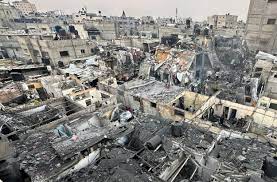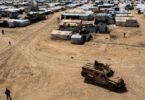Gaza (AFP): The United Nations said Tuesday its satellite analysis agency UNOSAT had determined that 18 percent of Gaza’s infrastructure had been destroyed since the outbreak of the Israel-Hamas war, following the unprecedented October 7 attack by the Palestinian militant group.
The estimate is based on an image taken on November 26, the agency said, a 49-percent increase in the total number of structures affected since a previous assessment on November 7.
“As of 26 November 2023, UNOSAT has identified 10,049 destroyed structures, 8,243 severely damaged structures, and 19,087 moderately damaged structures, totalling 37,379 structures affected,” it said.
“This corresponds to around 18% of the total structures in the Gaza Strip.”
The war began with Hamas’s October 7 attacks that killed 1,200 people, mainly civilians, according to Israeli figures, and saw around 240 hostages taken back to Gaza.
Israel has responded with a relentless offensive of air strikes and ground assaults aiming to destroy Hamas that has reduced much of Gaza to rubble, leaving more than 18,000 people dead, mostly civilians, according to the Hamas-run health ministry.
“These findings underscore the urgent need for immediate ceasefire and support to address the growing humanitarian crisis in the Gaza Strip,” UNOSAT said.
“The impact on civilian infrastructures is evident, with thousands of homes and essential facilities being damaged.”
Egypt sends 80 trucks to reopened Gaza checkpoint: humanitarian sources
Egypt sent an aid convoy of 80 trucks on Tuesday to the reopened Kerem Shalom crossing from Israel into war-torn Gaza for inspection, according to humanitarian sources in Egypt.
Another 100 trucks were sent to the Nitzana border post, which has been processing all international aid from Egypt’s Rafah border crossing before it is allowed into Gaza.
Israel agreed on Tuesday to reopen Kerem Shalom as a checkpoint to inspect aid into Gaza, where more than 18,400 people have been killed in the conflict, according to the health ministry in the Hamas-run Palestinian territory.
Kerem Shalom was used for 60 percent of goods entering the besieged Palestinian territory before October 7, when Hamas militants attacked Israel, killing 1,200 people and taking 240 hostages back to Gaza, according to Israeli officials.
No new direct crossings will be opened, Israel said, but the Kerem Shalom crossing would be used to check trucks before sending them in through Rafah.
After more than two months of war that have reduced much of Gaza to rubble, UN agencies and aid groups fear the territory will soon be overwhelmed by starvation and disease.
The visiting chief of UNRWA, the UN agency for Palestinian refugees, Philippe Lazzarini, on Tuesday likened Gaza to “hell on earth”.
For two months, aid has trickled in through the Rafah crossing with Egypt, where trucks remain backed up, but only a fraction have been allowed in every day.
UN humanitarian agency OCHA said Sunday around 100 trucks per day were bringing humanitarian supplies from Egypt into Gaza since a week-long truce ended on December 1, compared with a daily average of 500 before the war.
Shipments are sent to the Nitzana border post controlled by Israel where they are inspected and then sent back to Gaza.
The Israeli military said on Tuesday reopening Kerem Shalom would allow them to “double” aid reaching Gaza, as Israel faces mounting pressure for a humanitarian ceasefire.
“Today we screened the first batch of aid trucks for possible Hamas weapon-smuggling at Kerem Shalom before they drove to the Rafah crossing,” Israeli government spokesman Eylon Levy said.
“The problem is the bottleneck at the crossing with Egypt and the problem is that Israel is currently inspecting aid quicker than UN agencies on the ground are able to deliver it,” he added.
The UN General Assembly is due to vote Tuesday on a non-binding resolution demanding an immediate humanitarian ceasefire in the Gaza Strip.
The United States last week vetoed a Security Council resolution for a ceasefire.







